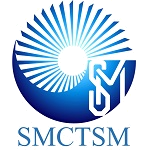Caracterización de capas de GaAs y GaAsMn depositadas por magnetrón sputtering (Characterization of GaAs and GaAsMn layers deposited by magnetron sputtering)
Keywords:
Semiconductores, Magnetron sputtering, Espectroscopia RamanAbstract
En este trabajo presentamos los resultados de crecimiento y caracterización de capas de GaAs y aleaciones semi-magnéticas de GaAsMn depositadas por magnetrón sputtering sobre un substrato de silicio (100). Los patrones de difracción de rayos X de GaAs y GaAsMan indican que la capa de GaAs es policristalina y presenta una orientación preferencial a lo largo de la dirección (111), mientras que la capa de GaAsMn tiene una fase de GaAs (002) y una fase asociada a MnAs. Los espectros Raman de GaAs y GaAsMn evidencian modos vibracionales LO y TO asociados a GaAs y otros modos vibracionales asociados a defectos en la capa de GaAsMn. Los espectros de electrones de rayos X indican que la superficie de la capa GaAs contiene enlaces de 18.45 y 18.46 eV debidos a Ga3d y As3d, respectivamente. Las medidas SIMS en perfil de concentración vs profundidad sobre la capa de GaAsMn indican señales asociadas a los elementos Ga, As y Mn, siendo éste un buen indicativo de la formación de la aleación ternaria GaAsMn. La caracterización magnética demostró que la capa de GaAs tiene un comportamiento diamagnético a bajas y altas temperaturas, mientras que la capa de GaAsMn exhibe un comportamiento paramagnético desde 50 hasta 300 K. La curva de M vs. T presenta un comportamiento anómalo por debajo de 50 K, donde el aumento de la magnetización se debe a un incremento de la polarización de espines. Finalmente, se concluye que es posible obtener capas de GaAs y GaAsMn policristalinas con propiedades físicas interesantes utilizando una técnica de depósito no epitaxial.
In this work we present results on the growth and characterization of layers of GaAs and the semi-magnetic alloy GaAsMn deposited by magnetron sputtering over silicon (100) substrate. X ray diffraction patterns of GaAs and GaAsMn indicate that GaAs layer is polycrystalline with preferential orientation along the (111) direction, while the GaAsMn layer has a phase of GaAs (002) and a phase associated to MnAs. The Raman spectra of GaAs and GaAsMn evidence LO and TO vibrational modes associated to GaAs and other vibrational modes associated to defects in the GaAsMn layer. The spectra for X ray photoelectrons indicate that the surface of GaAs layer contains bonds at 18.45 and 18.46 eV due to Ga3d and As3d, respectively. SIMS measurements in deepth profile of concentration on the GaAsM layer indicate signals associated with Ga, As and Mn elements, being a good indicative on the formation of the ternary alloy GaAsMn. The magnetic characterization showd that GaAs layer has a diamagnetic behaviour at low and high temperatures, while the GaAsMn layer exhibits a paramagnetic behaviour from 50 to 300 K. The M vs T curve shows an anomalous behaviour below 50 K, where the increment on magnetization is owed to an increase in spin polarization. Finaly, it is concluded that it is feasible to obtain GaAs and GaAsMn polycrystalline layers with interesting physical properties using a non epitaxial deposition technique.
References
. Erlacher, M. Ambrico, V. Capozzi, V. Augelli, H. Jaeger, B. Ullrich, Semicond. Sci. Technol. 19, 1322 (2004).
http://dx.doi.org/10.1088/0268-1242/19/11/019
. R.R. Campomanes , J.H. Dias da Silva , J. Vilcarromero , L.P. Cardoso, J. Non-Cryst. Solids 299, 788 (2002).
http://dx.doi.org/10.1016/S0022-3093(01)00983-8
. M. Imaizumi, M. Adachi, Y. Fujii, Y. Hayashi, T. Soga, T. Jimbo, M. Umeno, Journal of Crystal Growth 221, 688 (2000).
http://dx.doi.org/10.1016/S0022-0248(00)00801-0
. J. Vilcarromero, R. Bustamante, J.H.D. da Silva, Braz. J. Phys. 36, 1035 (2006).
http://www.redalyc.org/articulo.oa?id=46436563
. I. P. Soshnikov, V. G. Dubrovskii, N. V. Sibirev, V. T. Barchenko, A. V. Veretekha, G. E. Cirlin, V. M. Ustinov, Tech. Phys. Lett. 32, 520 (2006).
http://dx.doi.org/10.1134/S1063785006060216
. Y. Yan-Ping, L. Chun-Ling, Q. Zhong-Liang, L. Mei, G. Xin, B. Bao-Xue, Chin. Phys. Lett. 25, 1071 (2008).
http://dx.doi.org/10.1088/0256-307X/25/3/072
. S. Ye, PhD Thesis “Magneto-transport in (Ga,Mn)As-based alloys and hybrids” (Philipps-Universität Marburg, 2005).
http://archiv.ub.uni-marburg.de/diss/z2005/0130
. A.L. Patterson, Phys. Rev. 56, 978 (1939).
http://dx.doi.org/10.1103/PhysRev.56.978
. C. Hamaguchi, Basic Semiconductor Physics (Springer-Verlag, Berlin, 2010) Cap. 5.
http://dx.doi.org/10.1007/978-3-642-03303
. P. Puech, G. Landa, R. Carles, C. Fontaine, J. Appl. Phys. 82, 4493 (1997).
http://dx.doi.org/10.1063/1.366182
. S.C. Jain, M. Willander, H. Maes, Semicond. Sci. Technol. 11, 641 (1996).
http://dx.doi.org/10.1088/0268-1242/11/6/022
. J.I. Pankov, Optical Processes in Semiconductors (Dover, New York, 1971) pp. 1-34.
http://store.doverpublications.com/0486602753.html
. R. Trommer, M. Cardona. Phys. Rev. B 17, 1865 (1978).
http://dx.doi.org/10.1103/ PhysRevB.17.1865
. P. Streubel, R. Hesse, L. Makhova, J. Schindelka, R. Denecke. “A Practicable Method for Thickness Estimation of Ultrathin Layers from XPS Data with UNIFIT 2011”. Technical Report, July 29, 2011.
http://www.uni-leipzig.de /~unifit/Publkation_pdf/Technical_Report_Thickness_Estimation.pdf
. T. Mihailova, N. Velchev, V. Krastev, T. Marinova, Appl. Surf. Sci. 120, 213 (1997).
http://dx.doi.org/10.1016/S0169-4332(97)00249-3
. NIST X-ray Photoelectron Spectroscopy (XPS) - SRDATA at NIST.
http://srdata.nist.gov/xps/ main_search_menu.aspx
. J. Caetano de Souza, A. Ferreira, H. Vargas, J. Phys. IV C7, 129 (1994).
https://hal.archives-ouvertes.fr/jpa-00253259
. J.S. Blakemore, J. Appl. Phys. 53, 123 (1982).
http://dx.doi.org/10.1063/1.331665
. J. Mira, F. Rivadulla, J. Rivas, A. Fondado, T. Guidi, R. Caciuffo, F. Carsughi, P. G. Radaelli, J. B. Goodenough, Phys. Rev. Lett. 90, 097203 (2003).
http://dx.doi.org/10.1103/PhysRevLett.90.097203
. M.R. Slam, N.F. Chen, M. Yamada, Mat. Sci. Semicon. Proc. 9, 184 (2006).
http://dx.doi.org/10.1016/j.mssp.2006.01.059
. T. Sauncy, M. Holtz, R. Zallen, Phys. Rev B. 50, 10702 (1994).
http://dx.doi.org/10.1103/ PhysRevB.50.10702
Downloads
Published
Issue
Section
License
Copyright (c) 2016 Superficies y Vacío

This work is licensed under a Creative Commons Attribution 4.0 International License.
©2025 by the authors; licensee SMCTSM, Mexico. This article is an open access article distributed under the terms and conditions of the Creative Commons Attribution license (http://creativecommons.org/licenses/by/4.0/).





